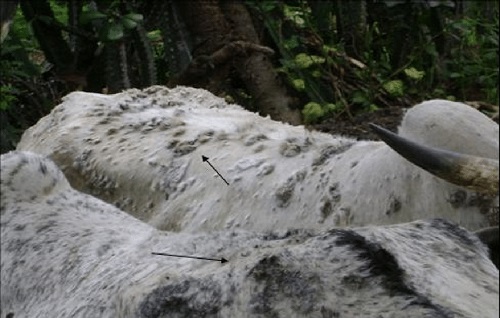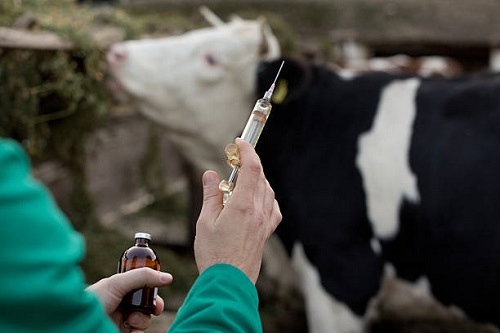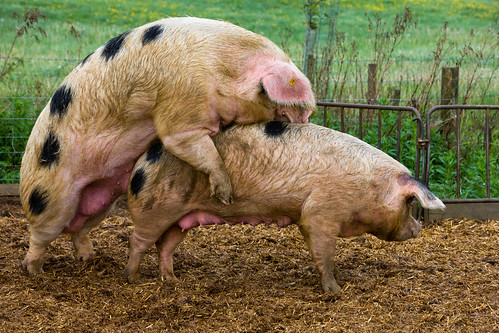Dermatophilosis, called Kirchi in Nigeria, is a zoonotic skin and bacterial disease caused by Dermatophilus congolensis or D. congolensis. This infection is characterized by the formation of hard crusts that stick firmly to the affected skin and it affects animals like cattle, horses, goats, sheep, pigs, dogs and humans.
Why is Dermatophilosis (Kirchi) Important in Livestock Farming?
In the tropics and subtropics, Dermatophilosis mostly affects cattle. Morbidity can be very high while mortality is often low. However, why this disease is of great economic importance is that it gives the affected animals rough, disgusting and ugly looks as the skins of such animals are full of lesions that degenerate to scabs or crusts. Another vital effect of Kirchi is that it greatly reduces the market value of animals. In Nigeria, cattle skin (called ponmo) is consumed by most people. Unfortunately, the skin of cattle affected by dermatophilosis is not fit for human consumption. This would result in financial loss for the farmer.
How Does Dermatophilosis Develops in Farm Animals?
Once the D. congolensis pathogen overcomes the skin barrier, it invades the epidermis (especially the hair follicle or wool) producing acute dermatitis and rapid cornification of the infected area. A secondary bacterial invasion is often associated with producing a copious exudate.
In cattle, the exudate, the remains of epithelium and the hairs, give rise to the formation of crusts that at first are soft and then dry and harden. Finally, alopecia occurs making the affected skin area hairless. In sheep there is a caking of wool fibers and when dried forms lumpy wool.
How is Dermatophilosis Transmitted?
- Flies and ticks act as mechanical vectors of the disease. It can be transmitted by the bite of flies and ticks after feeding in skins areas with wet lesions.
- Hot and humid weathers predispose animals to the disease.
- Close body contact of healthy animals with infected animals
- In some cases, plants with thorns and even profuse rains can injure the lipid and keratinous layers of the skin facilitating the entry of the bacterium spores into the epidermis.
- Overcrowding in pens during rainy seasons also contributes to the dispersion of the disease agent.
What are the Signs and Symptoms of Dermatophilosis (Kirchi)?
In cattle, dermatophilosis appears at all ages but is more common in young animals. The lesions usually start from the neck and extend down the chest wall. The lesions consist of cream to brown corneal crusts. In the initial stage, the scabs are very adherent and when detaching them they cause pain, exposing granulation tissue and sometimes pus when secondary infections occur Finally, the healing of dermatitis begins and the scabs separate from the skin but remain attached to the hairs and the loss of hair or wool is observed (alopecia).
In calves, the first lesions almost always appear in the mouth and peri-ocular area and then spread to the head, neck and rest of the body. The formation of scabs with the grouping of hairs, marked alopecia and thickening of the skin with the formation of folds is observed. In the mother, scabs are usually observed on the udder, near the teats or in the anterior part of the mammary gland.
In sheep, the scabs are thicker, rough, circular and often pigmented. They are generally distributed in the lateral and ventral areas. The fleece or wool loses practically all its commercial value.
How to Treat Dermatophilosis (Kirchi)
In acute cases, the course of the infection is usually short and the animals recover spontaneously. Dry weather favors recovery. The application of topical antiseptics is of doubtful value because they have no effect on the hyphae found inside the woolly or hair follicle, although they help reduce spread through the destruction of organisms present in the crusts.
If many animals are affected, 0.2-0.5% zinc sulfate can be used in plunge or spray dips. Different parenteral treatments have been tested. Persistent infections can be cured with a single injection of 45,000-70,000 IU/kg of penicillin G procaine and 45-70 mg/kg of streptomycin. Good results have been obtained in cattle with tetracyclines (5 mg/kg) repeated weekly if it is necessary. In sheep, a single injection of 20 mg/kg of long-acting oxytetracycline L.A. has given good results.
How to Control or Prevent Dermatophilosis (Kirchi)
The disease usually disappears spontaneously in cold and dry weather. In the event of the onset of the disease, it is advisable to isolate the sick, reduce the movement of the animals. In the event of having to carry out handling tasks, carry the batch affected last and then disinfect the facilities and equipment or tools used.
Plunge dip liquids can become contaminated and act as disseminators of the disease. The inclusion of zinc sulfate helps control the spread of D. congolensis.



